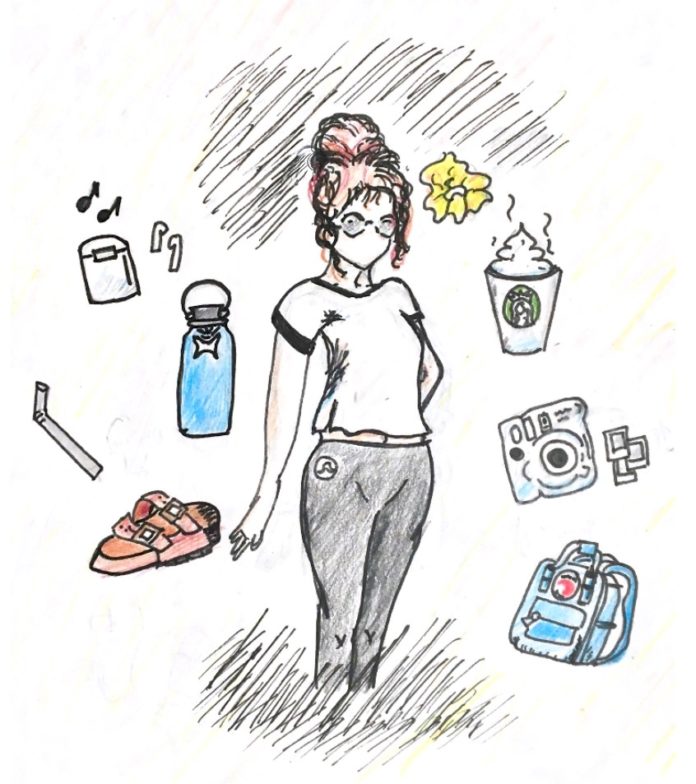“I’m Not Like Other Girls”: The Modern Quirky-Relatable Greaser Girl
Lauren Luna
Contributing Writer
The “I’m not like other girls” cultural phenomenon is a reaction against typically feminine stereotypes — that is, makeup, fashion, fitness, and the like. Some girls who don’t fit said archetype attempt to separate themselves from the female population, hence the phrase “I’m not like other girls.”
The “I’m not like other girls” claim isn’t a recent issue; we’ve just seen it occur in different forms across the decades. In the 1950s, the “greaser girl” emerged in response to the staunch conservatism of its time. In the 1980s and 1990s, the “grunge model” type grew in popularity, idolized for her unapologetic attitude towards self-expression and societal constructs.
Our current version of this phenomenon is the “quirky-relatable teen.” The rise of “relatable” YouTubers is a direct response to the widespread popularity of beauty gurus, who began their reign in 2012. This trend originated with smaller YouTubers like “enjajaja” and is now made up of influencers like Emma Chamberlain, Haley Pham, and Hannah Meloche.
“Relatable YouTube,” with its sardonic humor and emphasis on minimal effort, initially proved to be a breath of fresh air when compared to the perfectionism of social media.
However, “I’m not like other girls” culture does court controversy. Most young boys attack the movement through comedy; a few years ago, a popular Vine trend was smushing cake on one’s face and saying “no makeup!” which was an obvious jab at girls who prefer a fully made-up (but still “natural”) face.
Modern feminism acknowledges that the “I’m not like other girls” movement carries hints of internalized misogyny, when girls proudly claim that they “are not like other girls”, it suggests that this “other” breed of girls is generally shallow and vapid with no other interests besides fashion, fitness, or beauty.
A popular subversion of the “I’m not like other girls” subculture celebrates young girls for all their interests whether they’re conventionally feminine or not, thus giving girls the chance to explore different parts of their identities without feeling ashamed, or needing to categorize themselves into one stereotype.
Most teenage girls either buy into the subculture or experience it briefly and cringe as they look back on it — I know I did. It’s not always the case that the girls who adopt this subculture actively try to put down their peers, but the very act of conscious separation subliminally attacks people who do have “basic” interests.
What we must remember is that feminine and non-feminine things are not mutually exclusive. While the actual interests of this subculture are fine, the intent behind it may be an issue if improperly understood and used for malicious means.
Celebrating our differences is wonderful, but letting other people enjoy what they enjoy is key to maintaining a positive presence amongst your peers and the world at large.
“Not Like Other Girls”: A Tale of the Modern Feminine Identity
Sofia Lyon
Contributing Writer
Young women today live in perhaps the most tumultuous and unprecedented time for women their age, creating a confused sense of femininity and womanhood. With the advent of VSCO girls, e-girls, and more, there are countless categories of femininity, all existing more or less in contradiction to one another.
There is a simultaneous resistance to all things “basic;” alternative women and girls are a mainstay in current media, acting as protagonists in films, novels, and television shows. These characters are often troubled, with an inexhaustible fervor for life and experience.
On the opposite end of the spectrum is where we would presume “basic” would lie. Despite its frequent application, the term, style, or personality lacks any concrete denotation.
What “basic” seems to imply is some ordinariness, or perhaps something relatively uncontroversial. But given its vague parameters, “basic” may just describe women who do not see external expression as their primary method of self-identification, making its scope incredibly broad.
Despite attempts to diverge, the trend toward this eclectic model remains an image to be desired; one that has the potential to be as harmful as its basic antithesis. There appears to be a problematic tendency to conflate complexity with difficulty, that being angsty or sad is intriguing and exciting.
However, there remains the issue of plainness — which often results in a superficial perception of young girls with more ambiguous identities. Ultimately, what we are left with are slightly variant sets of standards that pervade and govern youth culture, whether for image or behavior.
Regardless of these contentious aesthetics, the intention remains: to consolidate and simplify the otherwise vast and shapeless experience of femininity in the 21st century. So perhaps it is not a question of whether being “basic” or its converse is permissible, but why polarization between women exists.
Historically, the future of women was never uncertain; their directions were more or less contrived for them. Only recently has the world begun to open itself to all women and the diverse skills they possess. In a time of endless possibility and a promising future ahead, the comfort and camaraderie of appealing to a binary is a practice in grounding oneself in the physical.
To say one is “not like other girls” is a misrepresentation of how femininity manifests in the modern world. The act of identifying with womanhood is more complicated and dimensional than we can communicate with language.
There is no cryptic collective of “other girls,” existing singularly and similarly. We are all the other girl in the nebulous feminine identity, a solely independent experience.











